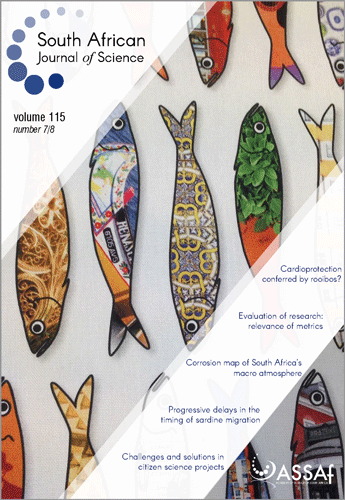Genetic diversity of African clawless otters (Aonyx capensis) occurring in urbanised areas of Gauteng, South Africa
DOI:
https://doi.org/10.17159/sajs.2019/4889Keywords:
Aonyx capensis, genetic health, urbanisation, distributionAbstract
Genetic diversity is the basis of the evolutionary potential of species to respond to environmental changes. However, restricting the movement of species can result in populations becoming less connected which can reduce gene flow and can subsequently result in a loss of genetic diversity. Urban expansion can lead to the fragmentation of habitats which affects the ability of species to move freely between areas. In this study, the genetic diversity of the African clawless otter (Aonyx capensis) in Gauteng (South Africa) was assessed using non-invasive sampling techniques. DNA was extracted from spraint (faecal) samples collected along nine rivers and genotyped using 10 microsatellites to assess population structure and genetic diversity. Samples were grouped based on locality and by catchment to determine whether isolated subpopulations exist. Genetic diversity of A. capensis in Gauteng was found to be low (mean observed heterozygosity (Ho)=0.309). Analysis of genetic structure provides support for the otter populations being panmictic with high gene flow between populations from different rivers. Results from the study indicate that the movement of A. capensis is not affected by physical barriers in urbanised areas. However, because the genetic diversity of the species in the study area is low, these animals may not be able to cope with future environmental changes.
Significance:
- Genetic structure analysis of the sampled Gauteng otter population indicates the population is panmictic; however, a low level of genetic diversity in this population has also been identified and may affect how the population copes with future environmental changes.
- Physical restrictions in urbanised areas do not appear to be affecting movement of the species.
Downloads
Published
Issue
Section
License

All articles are published under a Creative Commons Attribution 4.0 International Licence
Copyright is retained by the authors. Readers are welcome to reproduce, share and adapt the content without permission provided the source is attributed.
Disclaimer: The publisher and editors accept no responsibility for statements made by the authors
How to Cite
- Abstract 804
- PDF 793
- EPUB 220
- XML 438
- Supplementary Material 247












.png)